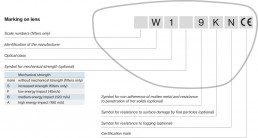The eyes are the most important and at the same time the most sensitive sensory organ. Approximately 85% to 90% of all perception involves the eyes. The protection provided by body’s natural features, such as eyelashes, tears, eyelids and blink reflex, rarely suffices in the industrial working world.
Personal protective equipment (PPE) is required if risks in the workplace cannot be entirely eliminated through technical and operational procedures. European legislation stipulates that it is the employers’ obligation to analyse the dangers in the working environment and, where required, ensure protective eyewear is made available to employees free of charge.
The standards for PPE have been defined in European Directive 89/686/EEC, while the guidelines for eye protection fall under EN 166. This is intended to help company owners fulfil their commitment to accident prevention regulations and government occupational health and safety directives as well as showing ways in which work-related accidents, illnesses and health hazards can be prevented.
All products tested in accordance with these directives are exposed to different dangers which can potentially damage the eyes and impair vision in industry, laboratories, schools and universities, among others. For example, all customised protective eyewear that features coated lenses labelled in accordance with K or N must meet the requirements of the standard EN 166 ff. (see image)

What do the K and N labels mean?
K labelling
Products must feature a high level of scratch-resistance in workplace environments with high dirt and dust exposure. Surface resistance to damage from small particles is tested by means of the sand trickling method and is carried out as follows:
- Lens is secured on a rotating plate
- 3 kg of natural quartz sand is trickled down onto the main focal area of the lens from a height of approximately 1.65 m at room temperature (23 °C)
- Afterwards, the light refraction of the samples is measured. < 5 = K
If safety eyewear is labelled K, the lenses have been certified in accordance with the standard EN 168 as resistant to damage from small particles and as having a light density coefficient that does not exceed 5.
The following industries typically demand this level of protection:
- Steel industry
- Mining
- Construction materials industry
- Construction industry
N labelling
Working environments with high humidity and persistent condensation place the extreme demands on products. Resistance of lenses to fogging is tested by means of the water bath method and is carried out as follows:
Preparation
- Lenses stored in distilled water for one to two hours -> patted dry
- Conditioned at room temperature (23°C) with 50% humidity for 12 hours
Experiment
- Water bath is heated to 50°C (surrounding environment: room temperature)
- Lens is attached over the opening of the water bath
- The transmission factor change (>20%) on introduction of light source is measured
–> Time taken for lenses to fog up is measured. > 8 seconds = N
If safety eyewear is labelled K, the lenses have been certified in accordance with the standard EN 168 as resistant to fogging and as remaining fog-free for at least 8 seconds, even after immersion in water.
The following industries typically demand this level of protection:
- Paper industry
- Food industry
- Textile processing
- Refrigerated warehouses
uvex’s coating systems that are developed and produced in-house far exceed the the requirements of the standard EN 168.
The right coating provides a specific protective function to ensure the eyewear is anti-fog, scratchproof and resistant to chemicals. Please visit the uvex website to discover more about uvex coatings for safety eyewear: http://goo.gl/dRe5JC
Please do not hesitate to contact us with any questions. Please email expertenblog@uvex.de and we will be happy to help.